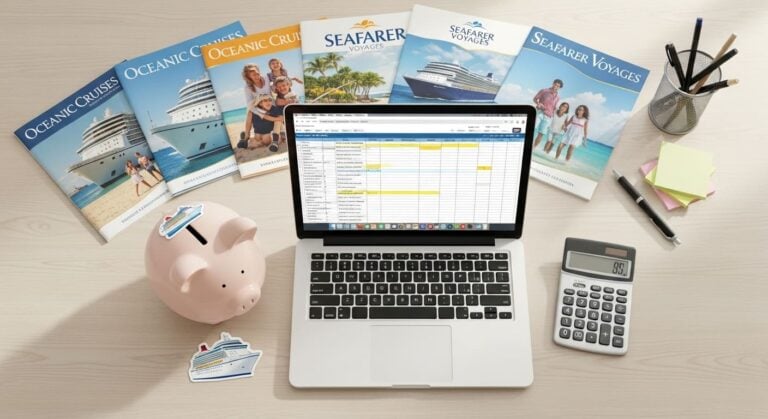How to Collect Money for a Group Trip (The Drama-Free Way)
For the Family C.E.O., your role is defined by logistics. You coordinate schedules, remember birthdays, and plan the holidays. When it comes to the big family vacation, you naturally step into the leadership position. But there is one aspect of this job that can induce more anxiety than any other: mixing family with finances—especially when figuring out how to collect money for a group trip.
The joy of planning a dream cruise or resort getaway can quickly be overshadowed by the awkward reality of collecting money. Chasing down your brother for his family’s deposit, gently reminding your parents about the final payment deadline, and keeping track of who has paid what in a messy spreadsheet can be incredibly stressful. It can create an uncomfortable dynamic, turning you from a beloved family leader into a reluctant bill collector. This friction can sour the entire experience before you’ve even packed a bag.
The solution is simple in concept but requires a strategic shift in your approach: you must remove yourself as the “banker.” To preserve your sanity and your relationships, you need a system that handles the financial transactions professionally and impartially. Let’s explore the common methods for collecting group funds, from the most stressful to the most seamless.
Of course, before you can even think about collecting money, you need to have a clear budget based on what everyone is comfortable with. The best way to establish one is by getting input from the whole group first. Find out the 5 essential family vacation survey questions to ask in our guide here.
Method 1: The DIY Approach (Venmo/Zelle)
For a simple weekend trip with a few friends, using a peer-to-peer payment app like Venmo or Zelle seems like the obvious choice. It feels easy, informal, and immediate. You can send a request, and in theory, the money appears in your account within minutes. Everyone is familiar with the technology, and there's no complex setup required.
However, for a large, multi-generational vacation with significant costs, this method is fraught with peril. Suddenly, you are personally responsible for tracking every single payment from multiple family units, often in installments. More importantly, you are the one who has to front the money on your personal credit card to secure the booking. This places a huge financial risk and liability squarely on your shoulders.
What happens if a family member is late with their payment and the non-refundable deposit deadline passes? The burden falls on you. You're also forced to send those awkward reminder texts that can strain relationships. The informal nature of these apps quickly breaks down when thousands of dollars are on the line.
Method 2: Using a Payment App (Splitwise)
Expense-tracking apps like Splitwise are brilliant tools for their intended purpose: tracking shared costs during a trip. They are perfect for creating a transparent and fair ledger of who paid for the group dinner, who covered the taxi fare, and who bought the groceries for the rental house. At the end of the trip, the app does the math and tells everyone who they owe.
The critical flaw in using these apps for pre-trip planning is that they track debt; they don't actually collect money. Splitwise won't help you when the cruise line requires a $5,000 deposit by Friday. It simply tells you that four other families now owe you $1,000 each. You are still the one paying the vendor, and you are still the one who has to initiate the collection process. It's a useful accounting tool, but it does not solve the core problem of getting funds from your family members to the travel supplier.
Method 3: The Professional Approach (A Travel Advisor)
This is the gold standard for group travel and the definitive solution for the Family C.E.O. who values their peace of mind. Engaging a travel advisor fundamentally changes the financial dynamic by introducing a neutral, professional third party to handle all transactions.
The process is seamless. The advisor sets up the group booking and provides secure, individual payment links to each family. Everyone can pay their portion directly to the supplier using their own credit card, earning their own points and managing their own finances. Your personal credit card is never used for anyone else's travel.
The advisor's system professionally tracks all payments and sends official reminders for important deadlines. A reminder from a travel business is a standard professional communication; a reminder from you can feel like a personal nag. This distinction is crucial for preserving harmony. By delegating the financial administration, you remove yourself from every awkward money conversation.
Plan the Fun, Not the Finances
While payment apps are useful for splitting a dinner bill on vacation, they are not equipped to handle the high-stakes logistics of pre-trip deposits and payments. The only truly stress-free and financially secure way to manage large group payments is to use a travel advisor. It allows you to offload the most stressful part of the planning process so you can focus on what truly matters: designing an unforgettable experience for the people you love.
Handling the budget is a critical step in the overall planning process. To see how this fits into the complete 5-step blueprint for a flawless family vacation, read our Ultimate Guide on How to Plan a Group Vacation Without Losing Your Mind.
Join The Sunday Journey
Where family connection meets effortless coordination
Receive weekly inspiration, practical wisdom, and heartfelt stories about creating beautiful, seamless travel experiences for the whole family.
I respect your privacy. Unsubscribe at any time. Your information will never be shared.







